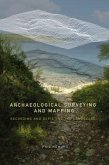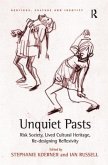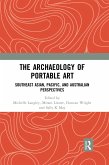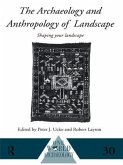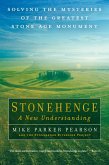Re-Mapping Archaeology
Critical Perspectives, Alternative Mappings
Herausgeber: Gillings, Mark; Lock, Gary; Hac&
Re-Mapping Archaeology
Critical Perspectives, Alternative Mappings
Herausgeber: Gillings, Mark; Lock, Gary; Hac&
- Broschiertes Buch
- Merkliste
- Auf die Merkliste
- Bewerten Bewerten
- Teilen
- Produkt teilen
- Produkterinnerung
- Produkterinnerung
This is a book about how archaeologists map, what they map and why they seek to map it. It is about the theoretical frameworks and craft traditions that underpin our established cartographic practices and the emergent assemblages of technologies, performances, desires and ways-of-doing that are giving rise to wholly new modes of mapping.
Andere Kunden interessierten sich auch für
![Archaeological Surveying and Mapping Archaeological Surveying and Mapping]() Philip HowardArchaeological Surveying and Mapping53,99 €
Philip HowardArchaeological Surveying and Mapping53,99 €![Unquiet Pasts Unquiet Pasts]() Stephanie KoernerUnquiet Pasts69,99 €
Stephanie KoernerUnquiet Pasts69,99 €![The Archaeology of Portable Art The Archaeology of Portable Art]() The Archaeology of Portable Art56,99 €
The Archaeology of Portable Art56,99 €![The Archaeology and Anthropology of Landscape The Archaeology and Anthropology of Landscape]() The Archaeology and Anthropology of Landscape74,99 €
The Archaeology and Anthropology of Landscape74,99 €![Stonehenge - A New Understanding Stonehenge - A New Understanding]() Mike Parker PearsonStonehenge - A New Understanding15,99 €
Mike Parker PearsonStonehenge - A New Understanding15,99 €![Oceanic Explorations: Lapita and Western Pacific Settlement Oceanic Explorations: Lapita and Western Pacific Settlement]() Oceanic Explorations: Lapita and Western Pacific Settlement42,99 €
Oceanic Explorations: Lapita and Western Pacific Settlement42,99 €![The Settlement of the American Continents: A Multidisciplinary Approach to Human Biogeography The Settlement of the American Continents: A Multidisciplinary Approach to Human Biogeography]() The Settlement of the American Continents: A Multidisciplinary Approach to Human Biogeography45,99 €
The Settlement of the American Continents: A Multidisciplinary Approach to Human Biogeography45,99 €-
-
-
This is a book about how archaeologists map, what they map and why they seek to map it. It is about the theoretical frameworks and craft traditions that underpin our established cartographic practices and the emergent assemblages of technologies, performances, desires and ways-of-doing that are giving rise to wholly new modes of mapping.
Produktdetails
- Produktdetails
- Verlag: Taylor & Francis Ltd (Sales)
- Seitenzahl: 362
- Erscheinungstermin: 30. Juni 2020
- Englisch
- Abmessung: 231mm x 155mm x 15mm
- Gewicht: 417g
- ISBN-13: 9780367588304
- ISBN-10: 0367588307
- Artikelnr.: 69894797
- Verlag: Taylor & Francis Ltd (Sales)
- Seitenzahl: 362
- Erscheinungstermin: 30. Juni 2020
- Englisch
- Abmessung: 231mm x 155mm x 15mm
- Gewicht: 417g
- ISBN-13: 9780367588304
- ISBN-10: 0367588307
- Artikelnr.: 69894797
Mark Gillings is a Reader in Archaeology at the University of Leicester specialising in the theory and practice of Landscape Archaeology. His fascination with archaeological theory, fieldwork, Geographical Information Systems and prehistoric monumentality are reflected in books such as Spatial Technologies and Archaeology (2002); Avebury (2004); Landscape of the Megaliths (2008) and, most recently, a four-volume critical reader in Landscape Archaeology (2016). Piraye Hac¿güzeller is a postdoctoral researcher at the Ghent Centre for Digital Humanities and the Archaeology Department of Ghent University. She has carried out postdoctoral research on the archaeological applications of GIS and critical mapping at KU Leuven and the University of Oxford, and is currently tasked with coordinating geospatial information activities at the Ghent Center for Digital Humanities. Gary Lock is Emeritus Professor of Archaeology at the University of Oxford, with a long-standing interest in the use of computers in archaeology ( Using Computers in Archaeology. Towards Virtual Pasts, 2003). He is particularly interested in the use of Geographical Information Systems in archaeology and their relationship to landscape theory and fieldwork practice (Archaeology and Geographical Information Systems, 1995; Beyond the Map. Archaeology and Spatial Technologies, 2000).
Acknowledgements
Contributors
Chapter 1 On maps and mapping
PART 1 Where do maps come from and what do they do?
Chapter 2 The map as assemblage: landscape archaeology and mapwork
Chapter 3 Cults of the distribution map: geography, utopia and the making of modern archaeology
Chapter 4 Feminist mapping for archaeologists: at the intersection of practices
PART 2 Practices of mapping
Chapter 5 The eye of the beholder: experience, encounter and objectivity in archaeo-topographical survey
Chapter 6 The craft of earthwork survey
PART 3 Experimental mappings and cartographic provocations
Chapter 7 Experimental mapping in archaeology: process, practice and archaeologies of the moment
Chapter 8 Here be worms: map art for the archaeologist (or how I learned to stop worrying and love artistic abstraction in maps)
Chapter 9 Describing Hermion/Ermioni. Between Pausanias and digital maps, a topology
Chapter 10 Re-thinking the conversation: a geomythological deep map
11 Mapping sound: creating a static soundscape
PART 4 Digital transformations
Chapter 12 Archaeology, digital cartography and the question of progress: the case of Çatalhöyük (Turkey)
Chapter 13 Cartography and quantum theory: in defence of distribution mapping
PART 5 When all is said and done
Chapter 14 Making maps: a commentary
Index
Contributors
Chapter 1 On maps and mapping
PART 1 Where do maps come from and what do they do?
Chapter 2 The map as assemblage: landscape archaeology and mapwork
Chapter 3 Cults of the distribution map: geography, utopia and the making of modern archaeology
Chapter 4 Feminist mapping for archaeologists: at the intersection of practices
PART 2 Practices of mapping
Chapter 5 The eye of the beholder: experience, encounter and objectivity in archaeo-topographical survey
Chapter 6 The craft of earthwork survey
PART 3 Experimental mappings and cartographic provocations
Chapter 7 Experimental mapping in archaeology: process, practice and archaeologies of the moment
Chapter 8 Here be worms: map art for the archaeologist (or how I learned to stop worrying and love artistic abstraction in maps)
Chapter 9 Describing Hermion/Ermioni. Between Pausanias and digital maps, a topology
Chapter 10 Re-thinking the conversation: a geomythological deep map
11 Mapping sound: creating a static soundscape
PART 4 Digital transformations
Chapter 12 Archaeology, digital cartography and the question of progress: the case of Çatalhöyük (Turkey)
Chapter 13 Cartography and quantum theory: in defence of distribution mapping
PART 5 When all is said and done
Chapter 14 Making maps: a commentary
Index
Acknowledgements
Contributors
Chapter 1 On maps and mapping
PART 1 Where do maps come from and what do they do?
Chapter 2 The map as assemblage: landscape archaeology and mapwork
Chapter 3 Cults of the distribution map: geography, utopia and the making of modern archaeology
Chapter 4 Feminist mapping for archaeologists: at the intersection of practices
PART 2 Practices of mapping
Chapter 5 The eye of the beholder: experience, encounter and objectivity in archaeo-topographical survey
Chapter 6 The craft of earthwork survey
PART 3 Experimental mappings and cartographic provocations
Chapter 7 Experimental mapping in archaeology: process, practice and archaeologies of the moment
Chapter 8 Here be worms: map art for the archaeologist (or how I learned to stop worrying and love artistic abstraction in maps)
Chapter 9 Describing Hermion/Ermioni. Between Pausanias and digital maps, a topology
Chapter 10 Re-thinking the conversation: a geomythological deep map
11 Mapping sound: creating a static soundscape
PART 4 Digital transformations
Chapter 12 Archaeology, digital cartography and the question of progress: the case of Çatalhöyük (Turkey)
Chapter 13 Cartography and quantum theory: in defence of distribution mapping
PART 5 When all is said and done
Chapter 14 Making maps: a commentary
Index
Contributors
Chapter 1 On maps and mapping
PART 1 Where do maps come from and what do they do?
Chapter 2 The map as assemblage: landscape archaeology and mapwork
Chapter 3 Cults of the distribution map: geography, utopia and the making of modern archaeology
Chapter 4 Feminist mapping for archaeologists: at the intersection of practices
PART 2 Practices of mapping
Chapter 5 The eye of the beholder: experience, encounter and objectivity in archaeo-topographical survey
Chapter 6 The craft of earthwork survey
PART 3 Experimental mappings and cartographic provocations
Chapter 7 Experimental mapping in archaeology: process, practice and archaeologies of the moment
Chapter 8 Here be worms: map art for the archaeologist (or how I learned to stop worrying and love artistic abstraction in maps)
Chapter 9 Describing Hermion/Ermioni. Between Pausanias and digital maps, a topology
Chapter 10 Re-thinking the conversation: a geomythological deep map
11 Mapping sound: creating a static soundscape
PART 4 Digital transformations
Chapter 12 Archaeology, digital cartography and the question of progress: the case of Çatalhöyük (Turkey)
Chapter 13 Cartography and quantum theory: in defence of distribution mapping
PART 5 When all is said and done
Chapter 14 Making maps: a commentary
Index


